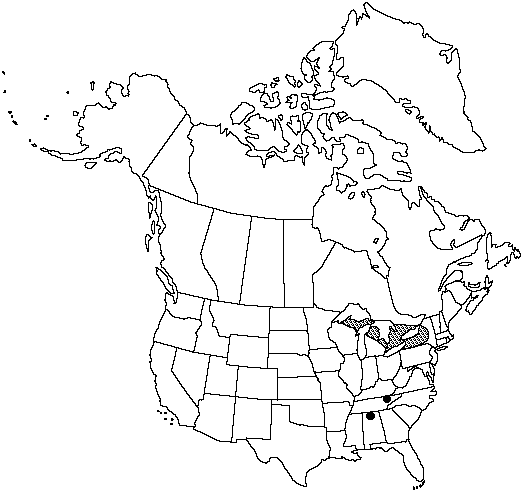Difference between revisions of "Asplenium scolopendrium var. americanum"
Phytologia 70: 196. 1991.
FNA>Volume Importer |
FNA>Volume Importer |
||
| Line 11: | Line 11: | ||
|name=Phyllitis scolopendrium var. americanum | |name=Phyllitis scolopendrium var. americanum | ||
|authority=Fernald | |authority=Fernald | ||
| + | |rank=variety | ||
|publication_title=Rhodora | |publication_title=Rhodora | ||
|publication_place=37: 220. 1935 | |publication_place=37: 220. 1935 | ||
| Line 17: | Line 18: | ||
|name=Phyllitis fernaldiana | |name=Phyllitis fernaldiana | ||
|authority=Komarov | |authority=Komarov | ||
| + | |rank=species | ||
}} {{Treatment/ID/Synonym | }} {{Treatment/ID/Synonym | ||
|name=Phyllitis japonica subsp. americana | |name=Phyllitis japonica subsp. americana | ||
|authority=(Fernald) A. Löve & D. Löve | |authority=(Fernald) A. Löve & D. Löve | ||
| + | |rank=subspecies | ||
}} | }} | ||
|hierarchy=Aspleniaceae;Asplenium;Asplenium scolopendrium;Asplenium scolopendrium var. americanum | |hierarchy=Aspleniaceae;Asplenium;Asplenium scolopendrium;Asplenium scolopendrium var. americanum | ||
| Line 35: | Line 38: | ||
|distribution=Ont.;Ala.;Mich.;N.Y.;Tenn.;Mexico in Nuevo León. | |distribution=Ont.;Ala.;Mich.;N.Y.;Tenn.;Mexico in Nuevo León. | ||
|discussion=<p><i>Asplenium scolopendrium</i> is rare and has a spotty distribution in North America. Consequently, when new populations are found, they receive considerable attention from pteridologists.</p><!-- | |discussion=<p><i>Asplenium scolopendrium</i> is rare and has a spotty distribution in North America. Consequently, when new populations are found, they receive considerable attention from pteridologists.</p><!-- | ||
| − | --><p>The American variety was distinguished from the European plants by M. L. Fernald (1935, pp. 220–221) on the basis of their smaller leaves, narrower scales with longer, attenuate tips, more promptly glabrate midribs, and blades tending to bear sori in the distal half rather than the entire length. In addition, M. L. Arreguín-Sánchez and R. Aguirre-Claverán (1986, pp. 400, 402) listed two differences in perispore morphology of the two varieties; they did not say how many specimens were studied. The most clear-cut difference is that the American plants are tetraploid and the European plants are diploid (D. M. Britton 1953), a difference insufficient for recognition of this taxon at specific rank (W. H. Wagner Jr. 1955b). More work is needed to determine if <i>Asplenium scolopendrium</i> var. lindenii (Hooker) Viane, Rasbach, & Reichstein, which occurs in southern Mexico (Oaxaca and Chiapas) and Hispaniola, is distinguishable from < | + | --><p>The American variety was distinguished from the European plants by M. L. Fernald (1935, pp. 220–221) on the basis of their smaller leaves, narrower scales with longer, attenuate tips, more promptly glabrate midribs, and blades tending to bear sori in the distal half rather than the entire length. In addition, M. L. Arreguín-Sánchez and R. Aguirre-Claverán (1986, pp. 400, 402) listed two differences in perispore morphology of the two varieties; they did not say how many specimens were studied. The most clear-cut difference is that the American plants are tetraploid and the European plants are diploid (D. M. Britton 1953), a difference insufficient for recognition of this taxon at specific rank (W. H. Wagner Jr. 1955b). More work is needed to determine if <i>Asplenium scolopendrium</i> var. lindenii (Hooker) Viane, Rasbach, & Reichstein, which occurs in southern Mexico (Oaxaca and Chiapas) and Hispaniola, is distinguishable from <i></i>var.<i> americanum</i>.</p> |
|tables= | |tables= | ||
|references= | |references= | ||
| Line 44: | Line 47: | ||
-->{{#Taxon: | -->{{#Taxon: | ||
name=Asplenium scolopendrium var. americanum | name=Asplenium scolopendrium var. americanum | ||
| − | |||
|authority=(Fernald) Kartesz & Gandhi | |authority=(Fernald) Kartesz & Gandhi | ||
|rank=variety | |rank=variety | ||
| Line 58: | Line 60: | ||
|publication year=1991 | |publication year=1991 | ||
|special status= | |special status= | ||
| − | |source xml=https://jpend@bitbucket.org/aafc-mbb/fna-data-curation.git/src/ | + | |source xml=https://jpend@bitbucket.org/aafc-mbb/fna-data-curation.git/src/eaa6e58056e40c9ef614d8f47aea294977a1a5e9/coarse_grained_fna_xml/V2/V2_730.xml |
|genus=Asplenium | |genus=Asplenium | ||
|species=Asplenium scolopendrium | |species=Asplenium scolopendrium | ||
Revision as of 19:50, 16 December 2019
Roots not proliferous. Stems erect, unbranched; scales brown, lanceolate, 3–6 × 1–1.5 mm, margins entire. Leaves monomorphic. Petiole brown to straw-colored, dull, 3–10 cm, 1/8–1/4 length of blade; indument of brown, narrowly lanceolate scales. Blade linear, simple, 8–35 × 2–4.5 cm, thick, papery, nearly glabrous; base cordate; margins entire; apex acuminate, not rooting. Rachis brown proximally, straw-colored distally, dull, glabrous. Veins free, obscure. Sori numerous, perpendicular to rachis, or nearly so, usually restricted to distal 1/2 of blade. Spores 64 per sporangium. Usually 2n = 144.
Habitat: On calcareous rocks in sinkholes, at cave entrances, and on cool, moist talus, always in deep shade
Elevation: 0–100 m
Distribution

Ont., Ala., Mich., N.Y., Tenn., Mexico in Nuevo León.
Discussion
Asplenium scolopendrium is rare and has a spotty distribution in North America. Consequently, when new populations are found, they receive considerable attention from pteridologists.
The American variety was distinguished from the European plants by M. L. Fernald (1935, pp. 220–221) on the basis of their smaller leaves, narrower scales with longer, attenuate tips, more promptly glabrate midribs, and blades tending to bear sori in the distal half rather than the entire length. In addition, M. L. Arreguín-Sánchez and R. Aguirre-Claverán (1986, pp. 400, 402) listed two differences in perispore morphology of the two varieties; they did not say how many specimens were studied. The most clear-cut difference is that the American plants are tetraploid and the European plants are diploid (D. M. Britton 1953), a difference insufficient for recognition of this taxon at specific rank (W. H. Wagner Jr. 1955b). More work is needed to determine if Asplenium scolopendrium var. lindenii (Hooker) Viane, Rasbach, & Reichstein, which occurs in southern Mexico (Oaxaca and Chiapas) and Hispaniola, is distinguishable from var. americanum.
Selected References
None.